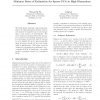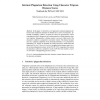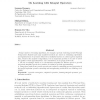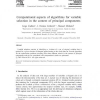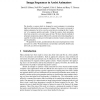JMLR
2012
12 years 11 months ago
2012
We study sparse principal components analysis in the high-dimensional setting, where p (the number of variables) can be much larger than n (the number of observations). We prove o...
CLEF
2011
Springer
13 years 8 months ago
2011
Springer
Abstract In this paper, we describe a novel approach to intrinsic plagiarism detection. Each suspicious document is divided into a series of consecutive, potentially overlapping �...
ACII
2011
Springer
13 years 8 months ago
2011
Springer
Abstract. In this study we propose a methodology to investigate possible prosody and voice quality correlates of social signals, and test-run it on annotated naturalistic recording...
JMLR
2010
14 years 6 months ago
2010
A large number of learning algorithms, for example, spectral clustering, kernel Principal Components Analysis and many manifold methods are based on estimating eigenvalues and eig...
IVC
2002
14 years 8 months ago
2002
Facial variation divides into a number of functional subspaces, and ensemblespecific variation. An improved method of measuring these is presented, within the space defined by an ...
CSDA
2004
14 years 8 months ago
2004
Variable selection consists in identifying a k-subset of a set of original variables that is optimal for a given criterion of adequate approximation to the whole data set. Several...
IR
2006
14 years 8 months ago
2006
Search facilitated with agglomerative hierarchical clustering methods was studied in a collection of Finnish newspaper articles (N = 53,893). To allow quick experiments, clustering...
NIPS
1994
14 years 9 months ago
1994
Understanding knowledge representations in neural nets has been a difficult problem. Principal components analysis (PCA) of contributions (products of sending activations and conn...
TREC
2000
14 years 9 months ago
2000
The main goal for the Information Space system for TREC9 was early precision. To facilitate this, an emphasis was placed on seeking matches from only the TITLE, H1, H2 and H3 tags...
BMVC
2000
14 years 9 months ago
2000
We describe a system which is designed to assist animators in extracting high-level information from sequences of images. The system is not meant to replace animators, but to be a...
